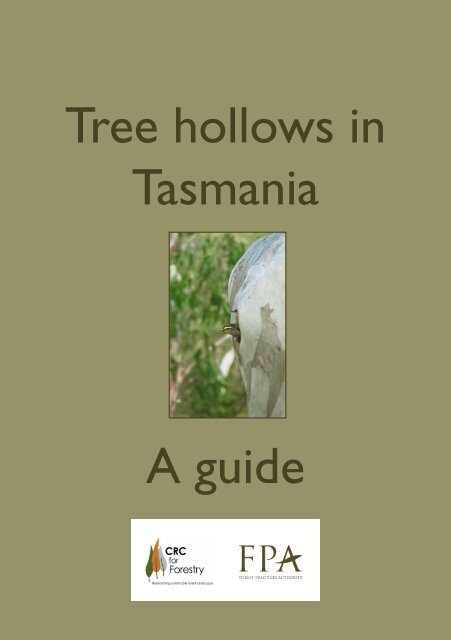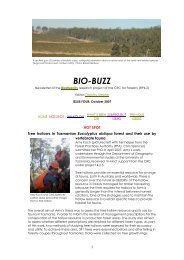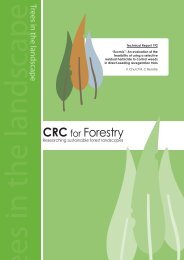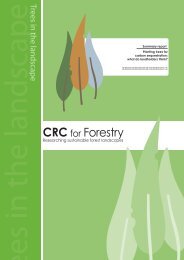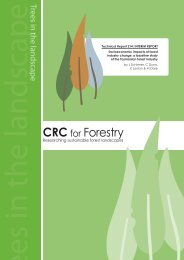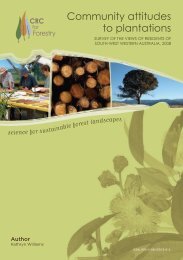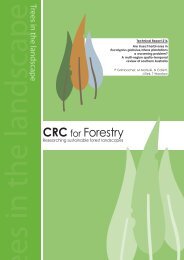Tree hollows in Tasmania A guide - CRC for Forestry
Tree hollows in Tasmania A guide - CRC for Forestry
Tree hollows in Tasmania A guide - CRC for Forestry
You also want an ePaper? Increase the reach of your titles
YUMPU automatically turns print PDFs into web optimized ePapers that Google loves.
ContentsWhat is a hollow and why is it important?....................................... 4Hollow related legislation..................................................................... 5How do <strong>hollows</strong> <strong>for</strong>m?......................................................................... 6What makes a good hollow? ............................................................... 7Hollow depth......................................................................................................7Entrance size.......................................................................................................7Hollow location..................................................................................................8Hollow shape......................................................................................................8Identify<strong>in</strong>g <strong>hollows</strong> ...............................................................................10False <strong>hollows</strong>....................................................................................................10Poor visibility....................................................................................................10Evidence of previous use............................................................................... 11Search<strong>in</strong>g <strong>for</strong> <strong>hollows</strong>..........................................................................12Select<strong>in</strong>g habitat trees.........................................................................13<strong>Tree</strong> diameter ..................................................................................................13Dead wood.......................................................................................................14<strong>Tree</strong> <strong>for</strong>m..........................................................................................................15Fire damage......................................................................................................16Select<strong>in</strong>g habitat trees – summary.............................................................. 17Habitat trees..........................................................................................18Recruitment trees................................................................................21How many <strong>hollows</strong> are enough?.......................................................22Nest-boxes – a practical solution?...................................................23Practical ideas <strong>for</strong> land managers......................................................24Retention..........................................................................................................24Protection.........................................................................................................25Recruitment .....................................................................................................25Additional read<strong>in</strong>g................................................................................26Appendix 1: <strong>Tasmania</strong>n hollow-us<strong>in</strong>g species .................................27Appendix 2: Flow diagram <strong>for</strong> identify<strong>in</strong>g habitat trees...............28
What is a hollow and why is it important?4<strong>Tree</strong> <strong>hollows</strong> are holesor cavities <strong>in</strong> trees thatprovide important shelterand breed<strong>in</strong>g sites <strong>for</strong> manyanimals. Hollows used byanimals <strong>in</strong> <strong>Tasmania</strong> rangefrom less than 2 cm to morethan 30 cm <strong>in</strong> entrancediameter. There are eightbat species, five arborealmarsupials (possums), about29 bird species (see Appendix1) and an unknown numberof <strong>in</strong>vertebrates that use<strong>hollows</strong> to vary<strong>in</strong>g degrees.This <strong>in</strong>cludes several speciesthat are listed as threatened.Seven of these hollow-us<strong>in</strong>gspecies are <strong>in</strong>troduced,<strong>in</strong>clud<strong>in</strong>g serious pests suchas the common starl<strong>in</strong>g. Itis important to considerthese <strong>in</strong>troduced specieswhen th<strong>in</strong>k<strong>in</strong>g about hollowdemand because theycompete with our nativehollow-users.The aim of this <strong>guide</strong> is tohelp people <strong>in</strong>terested <strong>in</strong>tree <strong>hollows</strong> to identify thetrees that are most likely tobe used by hollow-dependentspecies (see Appendix 1).
Hollow related legislationThe 1997 Regional Forest Agreement identified hollow-dependent faunaas priority species. Threatened hollow-us<strong>in</strong>g species need to beconserved under the Threatened Species Protection Act 1995.Production <strong>for</strong>est areas are subject to the Forest Practices Act 1985. Theassociated Forest Practices Code prescribes the manner <strong>in</strong> which <strong>for</strong>estpractices are to be conducted so as to provide reasonable protectionto the environment. As part of this, tree hollow management mustbe considered dur<strong>in</strong>g plann<strong>in</strong>g <strong>for</strong> and implementation of all <strong>for</strong>estoperations.A mosaic of modified and reta<strong>in</strong>ed areas where careful management of <strong>hollows</strong> is required.5
How do <strong>hollows</strong> <strong>for</strong>m?In Australia, some species of animals (e.g.cockatoos) can help enlarge <strong>hollows</strong>, but nospecies build <strong>hollows</strong> from scratch. Instead,<strong>hollows</strong> are produced by environmentalprocesses that take lots of time.The onset of hollow-<strong>for</strong>mation is dependenton damage to the tree, from fire, fromanimals (vertebrates or <strong>in</strong>vertebrates), orfrom branches dropp<strong>in</strong>g. Young and healthytrees can quickly heal after damage. As treesage they become slower at heal<strong>in</strong>g, allow<strong>in</strong>ghollow-<strong>for</strong>mation to progress. Termitesand beetles can bore <strong>in</strong>to the wood andhollow out extensive areas. Wounds provideentry-po<strong>in</strong>ts <strong>for</strong> fungal spores that can leadto active decay, that eventually rot out thetree. Fire can help enlarge <strong>hollows</strong> createdby other processes (although fire can alsodestroy <strong>hollows</strong>). <strong>Tree</strong>s less than 100 yearsold are unlikely to conta<strong>in</strong> <strong>hollows</strong>. <strong>Tree</strong>swith <strong>hollows</strong> suitable <strong>for</strong> use by animals aregenerally more than 150 years old.6Key factors <strong>for</strong> hollow <strong>for</strong>mation are:• physical damage• fire• fungi• <strong>in</strong>vertebrates (e.g. termites and beetles)• time.A hollow partially <strong>for</strong>med byfire (top);fruit<strong>in</strong>g fungal bodies near abasal hollow (bottom).
What makes a good hollow?(cont<strong>in</strong>ued)HOLLOW LOCATIONHollows can be found anywhere from thebase of the tree to the small branchesnear the tree top. Branches need to belarge enough to conta<strong>in</strong> a hollow bigenough to house an animal. While someanimals prefer a certa<strong>in</strong> height above theground, <strong>hollows</strong> at any height may be used.HOLLOW SHAPEA wide variety of hollow shapes can potentially be used by an animal, ifthe hollow is of the right size and <strong>in</strong> the right place. Hollow shapes thatcan be used <strong>in</strong>clude, but are not restricted to:• large jagged open<strong>in</strong>gs <strong>in</strong> the dead tops of trees• small round <strong>hollows</strong> <strong>in</strong> the trunk• the broken off end of branches• big jagged tears• small cracks.8From the top of the page go<strong>in</strong>g clockwise: circular <strong>hollows</strong> <strong>in</strong> the trunk; hollow <strong>in</strong> a branchend; crack hollow <strong>in</strong> the trunk; hollow where a branch has torn off.
A number of<strong>hollows</strong> known tohave been usedby fauna, show<strong>in</strong>gthe range of hollowtypes and shapesthat may be used,<strong>in</strong>clud<strong>in</strong>g a slenderbranch hollow witha tree mart<strong>in</strong> fly<strong>in</strong>gout (top right).9
FALSE HOLLOWSIdentify<strong>in</strong>g <strong>hollows</strong>What can, at first, appear to be a hollow may not actually be one.Common mistakes are th<strong>in</strong>k<strong>in</strong>g that small sta<strong>in</strong>s, burns, solid branchends or shallow cavities are actually <strong>hollows</strong>.10POOR VISIBILITYIt is obviously easier to detect <strong>hollows</strong> <strong>in</strong> dry open <strong>for</strong>est than densewet <strong>for</strong>est, but <strong>hollows</strong> will be missed <strong>in</strong> all <strong>for</strong>est types. More than halfof the <strong>hollows</strong> occurr<strong>in</strong>g <strong>in</strong> an area may be missed dur<strong>in</strong>g ground-basedsurveys. They may be hidden by the surround<strong>in</strong>g vegetation, by otherparts of the same tree or they may be fac<strong>in</strong>g upwards and so cannot beseen from the ground. The more time spent look<strong>in</strong>g, the more <strong>hollows</strong>are likely to be found.Clockwise from top left:what appears to be ahollow is actually a shallowfire scar; a spout thatis shallow and does notactually conta<strong>in</strong> a hollow;a burnt branch stub that<strong>in</strong> poor light<strong>in</strong>g looks like ahollow; a striated pardalotenest where the hollow is notvisible because it is fac<strong>in</strong>gupwards; the entranceto a green rosella hollowpartially obscured by foliage.
EVIDENCE OF PREVIOUS USEOne of the best ways of tell<strong>in</strong>g if a hollow is a good one is if it haspreviously been or is currently be<strong>in</strong>g used by animals. Evidence ofcurrent or previous use <strong>in</strong>cludes, but is not limited to:• rubb<strong>in</strong>g or chew<strong>in</strong>g marks around the hollow entrance• splash marks or dropp<strong>in</strong>gs at or near the hollow entrance• extensive scratch marks lead<strong>in</strong>g up to the hollow• visible nest<strong>in</strong>g material <strong>in</strong>side the hollow• an animal observed <strong>in</strong>side or enter<strong>in</strong>g the hollow!From left toright: rubb<strong>in</strong>gmarks aroundthe entrance toa hollow; a nestvisible <strong>in</strong>side ahollow; splashmarks around ahollow entrance.11
Search<strong>in</strong>g <strong>for</strong> <strong>hollows</strong>Hollow surveys are generally conducted near the base of the tree us<strong>in</strong>gb<strong>in</strong>oculars. When do<strong>in</strong>g hollow surveys it is a good idea to:• use a good pair of b<strong>in</strong>oculars• do searches <strong>in</strong> good weather• move around to f<strong>in</strong>d the best vantage po<strong>in</strong>t and try to look at thetree from all angles.Hollow surveys can work well <strong>for</strong> some trees and <strong>in</strong> some <strong>for</strong>est types,but not all <strong>hollows</strong> will be found. This means that it can be just as,and <strong>in</strong> some areas more important, to assess tree attributes as well assearch<strong>in</strong>g <strong>for</strong> <strong>hollows</strong>.12A <strong>for</strong>est researcher usesb<strong>in</strong>oculars to search <strong>for</strong><strong>hollows</strong> (right) and poorlight conditions make <strong>hollows</strong>pott<strong>in</strong>g difficult (above).
Select<strong>in</strong>g habitat treesA habitat tree is a tree that conta<strong>in</strong>s features such as <strong>hollows</strong> that arelikely to be used by fauna. Observ<strong>in</strong>g <strong>hollows</strong> is obviously the best wayof select<strong>in</strong>g a habitat tree and of assess<strong>in</strong>g hollow availability. The more<strong>hollows</strong> you can see <strong>in</strong> a tree, the more likely the tree is to conta<strong>in</strong> a <strong>hollows</strong>uitable <strong>for</strong> use by fauna.TREE DIAMETERA large diameter tree (above) and a medium diametertree (left). While either may conta<strong>in</strong> a hollow, thelarger diameter tree is much more likely to do so.Given that <strong>hollows</strong> take so long to <strong>for</strong>m, hollow-bear<strong>in</strong>g trees aretypically very old (>150 years and often much more <strong>for</strong> trees withlarge <strong>hollows</strong>). With<strong>in</strong> a particular area or <strong>for</strong>est type, the larger a treeis around the base, the older it is likely to be and the more likely it isthat the tree will have a hollow.13
Select<strong>in</strong>g habitat treesDEAD WOODDead wood <strong>in</strong> thecanopy of a tree generallymeans that the tree hasexperienced some stress.Stressed trees do not healas readily as healthy treesand there<strong>for</strong>e hollow<strong>for</strong>mation is more likely.A large, healthy tree with fewdead branches (right) and alarge tree with lots of large deadbranches which is, there<strong>for</strong>e, morelikely to conta<strong>in</strong> <strong>hollows</strong> (below).Dead branches can also bedropped by the tree and ahollow may <strong>for</strong>m where thebranch broke off. This meansthat the more dead branchesand the bigger the deadbranches you see <strong>in</strong> the canopyof a tree, the more likely thetree is to have a hollow.14Opposite page from top left to bottomright: trees with <strong>in</strong>creas<strong>in</strong>g levels ofsenescence. The crown starts out small,then grows, th<strong>in</strong>s, the number and sizeof dead branches <strong>in</strong>creases, the tree dies,loses its limbs and will eventually fall over.
TREE FORMAs trees age, their growth and senescence typically follows a sequencethat affects their <strong>for</strong>m and potential <strong>for</strong> develop<strong>in</strong>g <strong>hollows</strong>. <strong>Tree</strong>s withvery healthy crowns are less likely to have <strong>hollows</strong> than trees furtheralong this sequence. Dead trees may have a lot of <strong>hollows</strong>, but thesecan be lost as branches are dropped. While trees of any <strong>for</strong>m mayconta<strong>in</strong> <strong>hollows</strong>, the best shape <strong>for</strong> a habitat tree is one which is a livetree with dead wood and a crown of reasonable size.1 2345 678915
Select<strong>in</strong>g habitat trees (cont<strong>in</strong>ued)FIRE DAMAGEWhile fire can destroy hollowbear<strong>in</strong>gtrees and the <strong>hollows</strong>themselves, it can also help<strong>for</strong>m <strong>hollows</strong>. <strong>Tree</strong>s that havebeen damaged by fire aremore likely to have <strong>hollows</strong>.While burnt bark <strong>in</strong>dicates that a firehas passed through, it may have been a‘cool’ fire that didn’t actually damagethe tree. Fire scars, which often arefound at the base of the tree, are abetter sign that the fire may havehelped <strong>for</strong>m <strong>hollows</strong>.16A hollow partially <strong>for</strong>med by fire (top); a heavily and recently burnt <strong>for</strong>est that may havehollow-bear<strong>in</strong>g trees <strong>in</strong> the future (right); burnt bark on a tree <strong>in</strong>dicat<strong>in</strong>g a fire has gonethrough but there is little evidence of fire scarr<strong>in</strong>g on these trees (left).
Select<strong>in</strong>g habitat trees– summaryWhile this <strong>guide</strong> outl<strong>in</strong>es a number of features that should be looked<strong>for</strong> when select<strong>in</strong>g habitat trees, not all features will be found <strong>in</strong> an areaor on the same tree.What is required, then, is some common sense and good judgement.Look at the trees available and see which ones best fit the descriptionor have as many of the key attributes as possible.Key tree attributes <strong>in</strong>dicat<strong>in</strong>g hollow occurrence are:• visible <strong>hollows</strong> (the more the better)• large diameter• old age• dead wood <strong>in</strong> the tree (e.g. dead branches)• fire scarr<strong>in</strong>g.Look<strong>in</strong>g <strong>for</strong> habitat trees.17
Habitat treesOptimal habitat trees either have at least one large or several small<strong>hollows</strong> visible, or they have several other features suggest<strong>in</strong>g theyoffer prime habitat.Visible <strong>hollows</strong>, large diameter,dead wood, large canopyLarge diameter, dead wood, firescarr<strong>in</strong>g18Visible <strong>hollows</strong>, large diameter,dead woodVisible <strong>hollows</strong>, large diameter,dead wood
In areas where no trees have visible <strong>hollows</strong>, habitat trees should beselected from the trees available to conta<strong>in</strong> as many of the features<strong>in</strong>dicat<strong>in</strong>g hollow presence as possible.Very large tree, but little deadwood and no visible <strong>hollows</strong>Advanced tree <strong>for</strong>m with deadwood, although small crownSome dead branches but theseare small, the canopy is small andthere are no visible <strong>hollows</strong><strong>Tree</strong> shape is senescent but treecrown is very healthy and thereare no visible <strong>hollows</strong>19
Habitat trees (cont<strong>in</strong>ued)In some areas there may be little difference between trees <strong>in</strong> their size,<strong>for</strong>m or senescence. However, keep<strong>in</strong>g the key attributes of habitattrees <strong>in</strong> m<strong>in</strong>d can still help identify the best trees to reta<strong>in</strong>, even <strong>in</strong>these areas.Large diameter but no dead wood,no visible <strong>hollows</strong>Large tree but little dead wood,small canopy and no visible <strong>hollows</strong>20The largest tree with the mostbranch<strong>in</strong>g crown <strong>in</strong> the area,although has no dead woodFire damage and some deadwood but no visible <strong>hollows</strong> andthe tree is very small <strong>in</strong> diameter
Recruitment treesBecause tree <strong>hollows</strong> take such a long time to <strong>for</strong>m, it is important toth<strong>in</strong>k about how hollow availability will change <strong>in</strong> our landscape overtime. Recruitment trees are trees which may not provide a hollow now,but which will probably do so <strong>in</strong> the future if reta<strong>in</strong>ed.Good recruitment habitat trees are those from the age cohortyounger than the hollow-bear<strong>in</strong>g trees, but that are of reasonablesize and have the capacity to survive, grow and develop <strong>hollows</strong> overtime. Recruitment trees may be damaged, branchy or open-growntrees. Severely damaged or suppressed young trees are unlikely togrow further or respond to release and so are less important <strong>for</strong>consideration as recruitment trees.Left: no <strong>hollows</strong>, medium diameter, no dead wood, large canopy.Right: habitat tree on left, recruitment tree on right. Recruitment tree is the next largest treeafter the habitat tree. No <strong>hollows</strong>, medium diameter, little dead wood, large canopy.21
How many <strong>hollows</strong> are enough?The question ‘how many <strong>hollows</strong> are enough to ma<strong>in</strong>ta<strong>in</strong> populationsof native hollow-us<strong>in</strong>g species?’ is not easily answered. The numberrequired is likely to vary between areas and over time. Hollowus<strong>in</strong>ganimals vary <strong>in</strong> how dependent they are on <strong>hollows</strong>, how many<strong>hollows</strong> they will use <strong>in</strong> a year and the spac<strong>in</strong>g of the trees they use.Hollow-us<strong>in</strong>g species live at vary<strong>in</strong>g densities <strong>in</strong> different <strong>for</strong>est types,and <strong>in</strong> different areas of <strong>Tasmania</strong>. Hollow demand <strong>in</strong> an area can varyfrom year to year as some species move accord<strong>in</strong>g to food availablity.Available <strong>in</strong><strong>for</strong>mation currently suggests that more hollow-us<strong>in</strong>g speciesare found <strong>in</strong> the drier <strong>for</strong>ests <strong>in</strong> eastern <strong>Tasmania</strong> than the wetter<strong>for</strong>ests <strong>in</strong> the west.The number of <strong>hollows</strong> needed <strong>in</strong> an area depends on:• species diversity <strong>in</strong> the area• species abundance <strong>in</strong> the area• number of <strong>hollows</strong> used by an <strong>in</strong>dividual of each species• competition <strong>for</strong> <strong>hollows</strong>, e.g. with <strong>in</strong>troduced species• availability of other resources (e.g. food).22Scattered hollow-bear<strong>in</strong>g trees reta<strong>in</strong>ed <strong>in</strong> a highly modified area.
Nest-boxes – a practical solution?Nest-boxes (artificial <strong>hollows</strong>) can be used to help speciesconservation ef<strong>for</strong>ts <strong>in</strong> some situations. However, they are not areplacement <strong>for</strong> naturally occurr<strong>in</strong>g <strong>hollows</strong>.While nest-boxes can be successfully used by some species, and evenhelp <strong>in</strong> some species recovery programmes, we do not understandenough about the hollow requirements of many species to ensure theirbreed<strong>in</strong>g success <strong>in</strong> nest-boxes. We know animals can be very selective<strong>in</strong> their choice of <strong>hollows</strong>. This means that choice of nest-box entrancesize, the aspect and height at which the nest-box should be placed allrequire careful consideration.The diverse requirements of our hollow-us<strong>in</strong>g fauna means nestboxesare generally not a practical conservation strategy. The costs<strong>in</strong>volved <strong>in</strong> mak<strong>in</strong>g and hang<strong>in</strong>g nest-boxes, monitor<strong>in</strong>g, ma<strong>in</strong>ta<strong>in</strong><strong>in</strong>g andreplac<strong>in</strong>g them <strong>for</strong> even a s<strong>in</strong>gle species, comb<strong>in</strong>ed with our limitedunderstand<strong>in</strong>g of hollow requirements, mean that nest-boxes should beseen as a last resort <strong>for</strong> species conservation.Additional problemswith nest-boxes arethat they can potentially<strong>in</strong>crease populationsof <strong>in</strong>troduced and pestspecies, there is a risk ofdisease to the speciesus<strong>in</strong>g them and nestboxesdo not providethe other benefits thatnatural <strong>hollows</strong> provide(e.g. habitat <strong>for</strong> fungi and<strong>in</strong>vertebrates).Pygmy possum <strong>in</strong> nest box,photo Matt Webb.23
Practical ideas <strong>for</strong> land managersThe three ma<strong>in</strong> pr<strong>in</strong>ciples <strong>for</strong> goodhollow management <strong>in</strong> any location are:• retention• protection• recruitment.Right: firewood be<strong>in</strong>g obta<strong>in</strong>ed froma young tree rather than froman older tree conta<strong>in</strong><strong>in</strong>g <strong>hollows</strong>.RETENTION24Mature tree reta<strong>in</strong>ed with<strong>in</strong> a youngplantation.Older trees should be kept <strong>in</strong> an areawhenever possible.<strong>Forestry</strong> operations:Careful consideration should be takenwhen select<strong>in</strong>g trees to reta<strong>in</strong> <strong>in</strong> aharvest<strong>in</strong>g operation to ensure thatthe best quality trees available (<strong>in</strong>terms of provid<strong>in</strong>g <strong>hollows</strong>) are be<strong>in</strong>gkept.Other <strong>for</strong>est and land users:Instead of target<strong>in</strong>g older hollowbear<strong>in</strong>gtrees <strong>for</strong> firewood collection,target younger trees (alwaysensur<strong>in</strong>g enough recruitment treesare reta<strong>in</strong>ed). Th<strong>in</strong>k twice be<strong>for</strong>eremov<strong>in</strong>g paddock-trees.
PROTECTIONHollow-bear<strong>in</strong>g trees can be structurally less-sound than trees without<strong>hollows</strong>, mak<strong>in</strong>g them more prone to w<strong>in</strong>dthrow. The chances ofw<strong>in</strong>dthrow can be reduced by reta<strong>in</strong><strong>in</strong>g other trees around the hollowbear<strong>in</strong>gtrees.<strong>Forestry</strong> operations:Reta<strong>in</strong> hollow-bear<strong>in</strong>g trees <strong>in</strong> the middle of clumps or strips wheneverpossible rather than as isolated trees.Other <strong>for</strong>est and land users:Reta<strong>in</strong> other trees, or plant additional trees and shrubs around hollowbear<strong>in</strong>gtrees. Protect trees from livestock (e.g. by fenc<strong>in</strong>g).Right: stock damage prevent<strong>in</strong>gregeneration.RECRUITMENTBecause <strong>hollows</strong> takeso long to <strong>for</strong>m, it isimportant to ensurethat new trees areestablished to providefuture <strong>hollows</strong>.<strong>Forestry</strong> operations:Reta<strong>in</strong> younger recruitment trees as well as older hollow-bear<strong>in</strong>g trees.This can be achieved by reta<strong>in</strong><strong>in</strong>g trees <strong>in</strong> clumps and strips.Other <strong>for</strong>est and land users:In addition to reta<strong>in</strong><strong>in</strong>g and protect<strong>in</strong>g younger trees, plant<strong>in</strong>g trees orfenc<strong>in</strong>g around established trees can encourage regeneration.25
Additional read<strong>in</strong>gCawthen, L 2007, Den use by the common brushtail possum <strong>in</strong> logged and unlogged dry<strong>for</strong>est <strong>in</strong> SE <strong>Tasmania</strong>, Honours thesis, University of <strong>Tasmania</strong>, Hobart.Commonwealth of Australia and State of <strong>Tasmania</strong> 1996, <strong>Tasmania</strong>n-Commonwealth RegionalForest Agreement. <strong>Tasmania</strong>n Government, Hobart.Duhig, N, Munks, S, Wapstra, M and Taylor, R 2000, Mortality rates of reta<strong>in</strong>ed habitat trees <strong>in</strong>state <strong>for</strong>est coupes: a long-term monitor<strong>in</strong>g project – <strong>in</strong>itial report, <strong>Forestry</strong> <strong>Tasmania</strong> andthe Forest Practices Board, Hobart.Forest Practices Board 2000, Forest Practices Code, Forest Practices Board, Hobart, <strong>Tasmania</strong>.Gibbons, P and L<strong>in</strong>denmayer, D 2002, <strong>Tree</strong> Hollows and Wildlife Conservation <strong>in</strong> Australia,CSIRO Publish<strong>in</strong>g, Coll<strong>in</strong>gwood, Vic, Australia.Haseler, M and Taylor, R 1993, ‘Use of tree <strong>hollows</strong> by birds <strong>in</strong> sclerophyll <strong>for</strong>est <strong>in</strong> northeastern<strong>Tasmania</strong>’, Tas<strong>for</strong>ests 5: 51–56.Koch, AJ 2007, The abundance and type of <strong>hollows</strong> <strong>in</strong> Eucalyptus obliqua <strong>for</strong>est and the use ofthese <strong>hollows</strong> by fauna, PhD thesis, University of <strong>Tasmania</strong>, Hobart.Koch, AJ, Munks, SA and Whoeler, E 2008, ‘The hollow-us<strong>in</strong>g vertebrate fauna of <strong>Tasmania</strong>:distribution, hollow requirements and conservation status’, Australian Journal of Zoology56: 323–349.Koch, AJ, Munks, SA and Driscoll, D 2008, ‘The use of hollow-bear<strong>in</strong>g trees by vertebratefauna <strong>in</strong> wet and dry Eucalyptus obliqua <strong>for</strong>est, <strong>Tasmania</strong>’, Wildlife Research 35: 727–746.Koch, AJ, Munks, SA, Driscoll, D and Kirkpatrick, JB 2008, ‘Does hollow occurrence vary with<strong>for</strong>est type? A case study <strong>in</strong> wet and dry Eucalyptus obliqua <strong>for</strong>est’, Forest Ecology andManagement 255: 3938–3951.Koch AJ 2008, ‘Errors associated with two methods of assess<strong>in</strong>g tree hollow occurrence andabundance <strong>in</strong> Eucalyptus obliqua <strong>for</strong>est, <strong>Tasmania</strong>’, Forest Ecology and Management 255:674–685.Munks, SA, Wapstra, M, Corkrey, R, Otley, H, Miller, G and Walker, B 2007, ‘The occurrence ofpotential tree <strong>hollows</strong> <strong>in</strong> the dry eucalypt <strong>for</strong>ests of south-eastern <strong>Tasmania</strong>, Australia’,Australian Zoologist 34: 22–36.Taylor, RJ and Haseler, M 1993, ‘Occurrence of potential nest trees and their use by birds <strong>in</strong>sclerophyll <strong>for</strong>est <strong>in</strong> north-east <strong>Tasmania</strong>’, Australian <strong>Forestry</strong> 56: 165–171.Taylor, RJ and Savva, NM 1988, ‘Use of roost sites by four species of bats <strong>in</strong> State <strong>for</strong>est <strong>in</strong>south-eastern <strong>Tasmania</strong>’, Australian Wildlife Research 15: 637–645.Wapstra, M and Taylor, R 1998, ‘Use of reta<strong>in</strong>ed trees <strong>for</strong> nest<strong>in</strong>g by birds <strong>in</strong> logged eucalypt<strong>for</strong>est <strong>in</strong> north-eastern <strong>Tasmania</strong>’, Australian <strong>Forestry</strong> 61: 48–52.26
Appendix 1: <strong>Tasmania</strong>n hollow-us<strong>in</strong>g speciesSpecies Status HollowsizeBIRDSMusk lorikeetEndemicsubspeciesSmallRa<strong>in</strong>bow lorikeet Exotic SmallSwift parrot Native SmallOrange-bellied parrot Native SmallBlue-w<strong>in</strong>ged parrot Native Small<strong>Tree</strong> mart<strong>in</strong> Native SmallWelcome swallow Native SmallAustralian owlet-nightjarEndemicsubspeciesSmallDusky rob<strong>in</strong> Endemic SmallFlame rob<strong>in</strong> Native SmallForty-spotted pardalote Endemic SmallStriated pardalote Native SmallDusky woodswallow Native SmallCommon starl<strong>in</strong>g Exotic SmallSouthern boobook owlEndemicsubspeciesMediumPacific black duck Native MediumAustralian shelduck Native MediumChestnut teal Native MediumAustralian wood duck Native MediumGrey teal Native MediumGalah Exotic MediumLong-billed corella Exotic MediumLittle corella Exotic MediumLaugh<strong>in</strong>g kookaburra Exotic MediumEastern rosellaEndemicsubspeciesMediumGreen rosella Endemic MediumYellow-tailed blackcockatooNativeLargeSulphur-crested cockatoo Native LargeMasked owlEndemicsubspeciesLargeSpecies Status HollowsizePOSSUMS and GLIDERSSugar glider Exotic? SmallEastern pygmy possumKeyEndemicsubspeciesStatus:Endemic = found only <strong>in</strong> <strong>Tasmania</strong>Endemic subspecies = subspecies found only<strong>in</strong> <strong>Tasmania</strong>Native = historically found <strong>in</strong> <strong>Tasmania</strong>Exotic = recently <strong>in</strong>troduced to <strong>Tasmania</strong>? = classification is uncerta<strong>in</strong>Hollow size:(M<strong>in</strong>imum width of hollow entrance)Small = 2–5cmMedium = 6–10cmLarge = >10cmSmallLittle pygmy possum Native SmallCommon brushtailpossumCommon r<strong>in</strong>gtail possumBATSEndemicsubspeciesEndemicsubspeciesMediumMediumLesser long-eared bat Native SmallGreater long-eared batEndemicsubspeciesSmallGould’s wattled bat Native SmallChocolate wattled bat Native SmallLittle <strong>for</strong>est eptesicus Native SmallK<strong>in</strong>g River vespadelus Native SmallLarge <strong>for</strong>est vespadelus Native Small<strong>Tasmania</strong>n pipistrelle Native Small27


